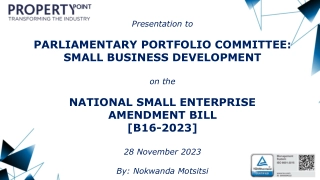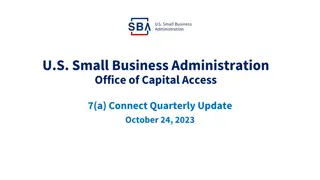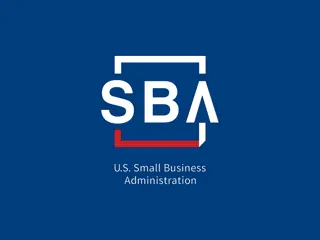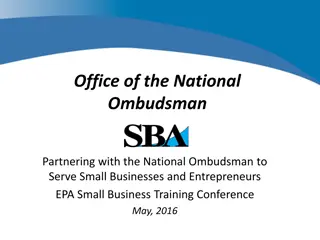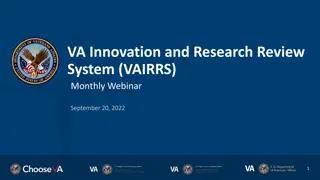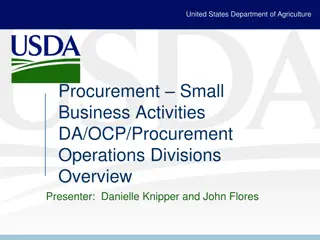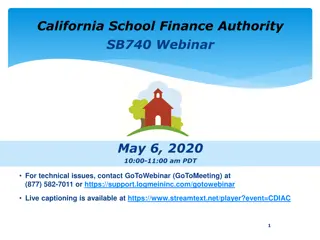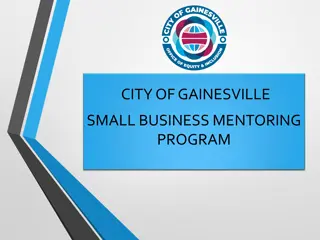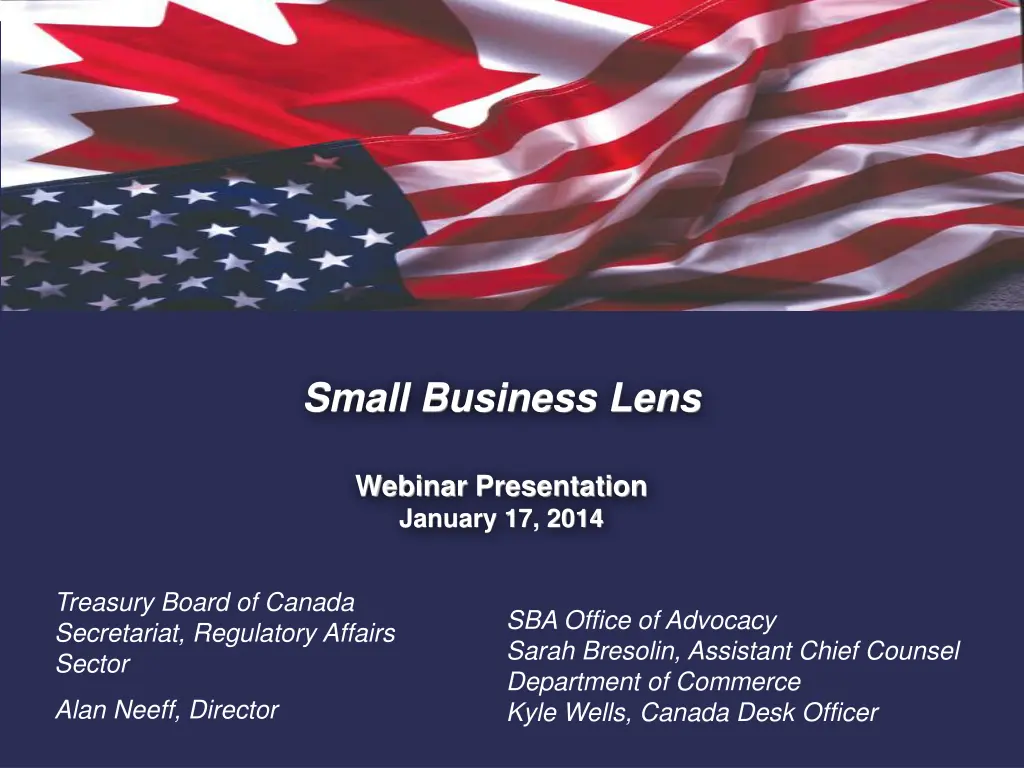
Canada-US Small Business Regulatory Alignment Initiative
Explore the Canada-US Small Business Regulatory Alignment Initiative focusing on minimizing burdens on small businesses while ensuring regulatory alignment. Track progress, tools, and milestones as both countries work towards greater regulatory flexibility for small business engagement and cross-border trade.
Download Presentation

Please find below an Image/Link to download the presentation.
The content on the website is provided AS IS for your information and personal use only. It may not be sold, licensed, or shared on other websites without obtaining consent from the author. If you encounter any issues during the download, it is possible that the publisher has removed the file from their server.
You are allowed to download the files provided on this website for personal or commercial use, subject to the condition that they are used lawfully. All files are the property of their respective owners.
The content on the website is provided AS IS for your information and personal use only. It may not be sold, licensed, or shared on other websites without obtaining consent from the author.
E N D
Presentation Transcript
Small Business Lens Webinar Presentation January 17, 2014 Treasury Board of Canada Secretariat, Regulatory Affairs Sector SBA Office of Advocacy Sarah Bresolin, Assistant Chief Counsel Department of Commerce Kyle Wells, Canada Desk Officer Alan Neeff, Director 1.
Content 1. Overview of the Initiative 2. Progress Update 3. Next Steps 4. Get Involved 5. Questions 2.
Overview of the initiative As Canada-US regulatory alignment is advanced under the RCC, ensure implementation of tools designed to minimize burden on small business do not inadvertently result in misalignment Canada U.S. Milestone Status 3-6 months Publish the Small Business Lens Add new features and content to Business.USA.gov 6-12 months Discuss tools used to consider and minimize regulatory burden on small business 12-18 months Highlight examples of regulatory flexibility for small businesses Help small businesses engage in the rule making process and find rules with international impacts In progress Beyond 18 Months Consider how to use regulatory process tools to achieve greater alignment of regulatory practices, and assist small businesses engaged in cross-border trade In progress 3.
Progress: US and Canadian tools to drive small business sensitivity align The working group has confirmed a high degree of commonality in how the countries hard-wire sensitivity to small business impacts of regulation Canada (Small Business Lens) U.S. (Regulatory Flexibility Act) Key Regulatory Process Requirements Identify the number of small businesses impacted and the estimated costs Consider flexible regulatory alternatives for small businesses Small businesses are consulted in the regulatory process Flexible alternatives must not compromise risk protection Results publicly available in regulatory impact analysis 4.
Progress towards the longer term goal has also been achieved Recent introduction of Canadian forward regulatory plans gives small business an early warning of upcoming regulations that may impact them 32 forward regulatory plans are now available on departmental Acts & Regulations web pages While the U.S. Regulatory Flexibility Act has required federal agencies to consider the effects of their regulatory actions on small businesses since 1980, U.S. regulators are currently developing new ways to engage small businesses in rulemakings that may affect trade with Canada Small businesses on both sides of the border now have tools to identify and engage on regulations impacting their business 5.
Next steps 12-18 month milestones (current): Canada to highlight examples of regulatory flexibility for small businesses in an Annual Scorecard Report, starting in Winter 2014 U.S. to help small businesses engage in the rule making process and find rules with international impacts Beyond 18 month milestone: As experience builds with application of the Small Business Lens, countries will share lessons learned and explore how Canadian and U.S. tools that provide flexibility for small business can be used together 6.
Get involved In Canada In the U.S. Review rulemakings and regulations at www.federalregister.gov Comment on rulemakings at www.regulations.gov Find answers to all of your small business questions at www.business.usa.gov See what s coming up at www.tbs-sct.gc.ca/tbs-sct/ar-lr/gwfrp- ppreg-eng.asp Get involved at www.consultingcanadians.gc.ca Review proposed regulations at www.gazette.gc.ca 7.
Outreach Questions 1. How can small business leverage the new regulatory process tools that have been developed (e.g. small business lens, forward plans)? 2. How can we use the web to raise small business awareness of these tools? 3. How can small businesses better engage in the rulemaking process? 4. Which small business concerns with the federal rule-making process warrant closer U.S. and Canada collaboration? 8.
Annex 1: U.S. Regulatory Flexibility Act and other Flexibility Mechanisms Regulatory Flexibility Act, 1980 (RFA) arose from Congressional recognition that one size fits all regulations had resulted in disproportionate effects on small entities. Federal agencies are required to consider the effects of their regulatory actions on small entities and where possible, mitigate them. Federal agencies must perform initial and final regulatory flexibility analyses for every rule published for notice and comment. (Generally, where a rulemaking is economically significant meaning that it will have an annual effect on the economy of $100 million or more.) Small Business Regulatory Enforcement Fairness Act 1996 (SBREFA), to amend the RFA Provides for judicial review of federal agency compliance with key RFA sections. Directed certain federal agencies to convene panels with small entity representatives when the agency is developing a rule where a flexibility analysis would be required. Presidential Memorandum, Regulatory Flexibility, Small Business, and Job Creation , 2011 Emphasizes federal agencies responsibility toward small businesses under the RFA. Directs agencies to explicitly justify any decisions not to provide flexibility for small businesses. 9.
Annex 2: Canadas Small Business Lens Part of the Government s Red Tape Reduction Action Plan, the Lens hardwires sensitivity to the impact of regulations on small business: Departments have to demonstrate that they have considered small business impacts at the earliest stages of regulatory design Application of the Lens is triggered when regulatory proposals have total costs of over $1M annually and that are expected to impact small business. Costs can be either administrative or compliance costs. The Lens requires regulators to: Complete a 20-point checklist and consult small business throughout regulatory design Develop an alternative implementation option that provides risk-appropriate flexibility for small business Demonstrate to decision-makers that the recommended option best minimizes burden without compromising risk protection Results of the Lens application are publicly available in Regulatory Impact Analysis Statements for new or amended regulations in the Canada Gazette, at www.canadagazette.gc.ca 10.
Annex 3: Forward Regulatory Plans in Canada: Environment Canada Example Flag for potential small business impacts Link: www.ec.gc.ca All Government of Canada forward plans available at: http://www.tbs-sct.gc.ca/tbs-sct/ar-lr/gwfrp-ppreg-eng.asp 11.
Annex 4: A new no wrong door internet platform for small businesses to quickly connect to the government services, resources and information they need. Assists small businesses find rulemakings and regulations by providing links to resources such as www.regulations.gov. Also includes resources related to accessing financing; beginning to export or starting a business; disaster assistance; and hiring. 12.

